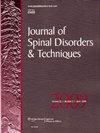Epidural Injections for Spinal Stenosis.
Q Medicine
引用次数: 0
Abstract
Epidural steroid injections (ESIs) are a common treatment for various types of lumbar spine pathology. Although ESI have been shown to contribute to successful nonoperative treatment in some patients with lumbar disk herniation, there is little evidence to suggest ESI alters the natural history of spinal stenosis or facilitates surgical avoidance.2 In this debate, we will argue that there is no role for ESI in the treatment of lumbar stenosis from a biological or clinical perspective. The biological rational for ESI in patients with chronic spinal stenosis is not concordant with the underlying pathophysiology of this disease process. Acute stenosis secondary to a disk herniation may have an inflammatory component that responds to ESI resulting in short-term benefit. This theory is supported by the SPORT subgroup analysis of lumbar disk herniation, which showed increased surgical avoidance in patients who received ESI but no difference in outcome measures between either group at 4 years.3 Unlike stenosis caused by disk herniation, biological mechanisms for resorption of osseous or ligamentous structures causing neural impingement do not exist. Chronic lumbar stenosis is likely symptomatic due to ischemic or vascular phenomena, not inflammation. Laboratory markers of inflammation are not uniformly elevated in patients with symptomatic lumbar stenosis either in the serum or in the epidural space. Prospective randomized control trials have shown no significant benefit of ESI over anesthetic or saline injections in patients with lumbar stenosis.4,5 Also there is concern regarding the potential deleterious systemic and local effect repetitive exposure to steroids can have on these patients, such as hyperglycemia, weight gain, epidural lipomatosis, or exacerbation of osteoporosis.6 Exposing the nerve roots of the cauda equina to epidural steroids in the setting of spinal stenosis may adversely affect neurological outcome. Radcliff et al,7 reported patients with lumbar spinal stenosis who received ESI had significantly less improvement at 4 years than patients without exposure to steroids in both the surgical and nonsurgical treatment groups. There is a growing body of clinical literature challenging the efficacy of ESI in patients with spinal stenosis. Despite this, ESIs are commonly administered to spinal stenosis patients and account for approximately 25% of all ESI in Medicare patients and 75% of patients who receive ESI in the Veterans Affairs system.8,9 The contention that ESI can facilitate surgical avoidance in patients with spinal stenosis is not supported clinically, as ESI are now often a prerequisite for surgical intervention. There is also a high correlation between ESI and increased rates of surgery for spinal stenosis in empirical databases.10 Finally, there is high-level data from a Level I study showing no difference between ESI and anesthetic injections in patients with spinal stenosis. Friedly et al published a multisite blinded prospective randomized control trial that evaluated if ESI and lidocaine provided any benefit over lidocaine alone at 6 weeks in patients with spinal stenosis. Four hundred patients were randomly assigned to either the treatment or placebo group, with the primary outcome measures at 6 weeks being average pain score and Roland Morris Disability Questionnaire (RMDQ). Although patients in the treatment group reported higher satisfaction scores, there was no statistically significant difference in any outcome measure between treatment and control groups at 6 weeks. Another doubleblind control trial randomized 100 patients with spinal stenosis into 1 of 2 groups receiving caudal injections with local anesthetic or local and steroid.12 There was no significant difference in outcome between the treatment and the control group with approximately 40% of patients in each group demonstrating clinical improvement at 2 years. In addition ESI are not benign, with complications such as cerebral spinal fluid leak, osteomyelitis, and epidural abscess reported in the literature. In review of the literature, it is hard to recommend ESI to patients with spinal stenosis. It should be noted that the randomized control trial conducted by Freidly and colleagues has been heavily criticized for flaws in the study design, methodology, and interpretation of results. There may be a role for ESI in patients with Received for publication March 22, 2015; accepted May 26, 2015. From the *Department of Orthopaedic Surgery, Thomas Jefferson University; and wDepartment of Orthopaedic Surgery, University of Pittsburgh Medical Center, Philadelphia, PA. The authors declare no conflict of interest. Reprints: Barrett I. Woods, MD, Thomas Jefferson University, 925 Chestnut Street, 5th Floor, Philadelphia, PA 19107 (e-mail: Barretti woodsmd@gmail.com). Copyright r 2015 Wolters Kluwer Health, Inc. All rights reserved. CONTROVERSIES IN SPINE SURGERY硬膜外注射治疗椎管狭窄。
本文章由计算机程序翻译,如有差异,请以英文原文为准。
求助全文
约1分钟内获得全文
求助全文
来源期刊
CiteScore
2.16
自引率
0.00%
发文量
0
审稿时长
3 months
期刊介绍:
Journal of Spinal Disorders & Techniques features peer-reviewed original articles on diagnosis, management, and surgery for spinal problems. Topics include degenerative disorders, spinal trauma, diagnostic anesthetic blocks, metastatic tumor spinal replacements, management of pain syndromes, and the use of imaging techniques in evaluating lumbar spine disorder. The journal also presents thoroughly documented case reports.

 求助内容:
求助内容: 应助结果提醒方式:
应助结果提醒方式:


